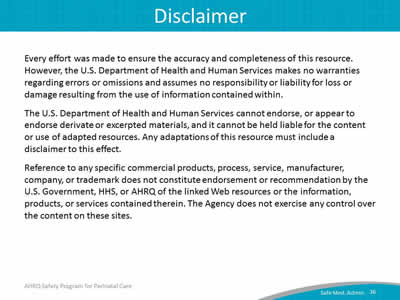Safe Medication Administration: Facilitator Guide
AHRQ Safety Program for Perinatal Care
Slide 1: Safe Medication Administration
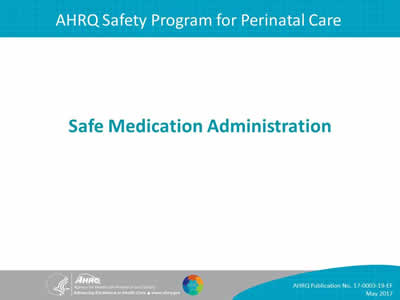
Say:
The Safe Medication Administration bundle provides information on high-alert medications commonly used in labor and delivery (L&D) units, and discusses the importance of implementing safeguards for their administration, providing an approach to developing those safeguards based on key safety elements.
Slide 2: Learning Objectives
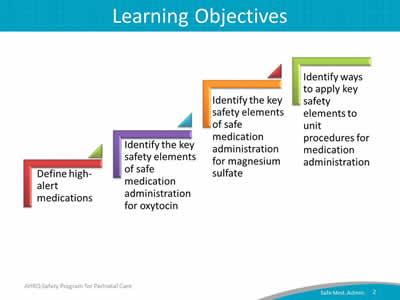
Say:
In this module, we will do the following:
- Define high-alert medications.
- Identify the key safety elements of safe medication administration for oxytocin.
- Identify the key safety elements of safe medication administration for magnesium sulfate.
- Identify ways to apply key safety elements to unit procedures for medication administration.
Slide 3: Safe Administration of Medications in L&D
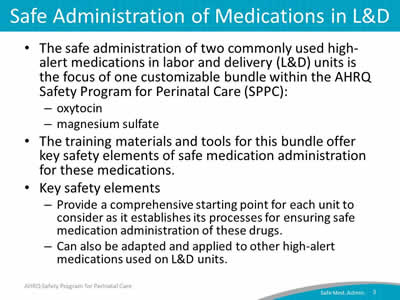
Say:
This bundle in the AHRQ Safety Program for Perinatal Care (SPPC) focuses on the safe administration of two high-alert medications commonly used in L&D units:
- Oxytocin.
- Magnesium sulfate.
The training materials and tools for this bundle offer key safety elements for safe administration of these medications. These key safety elements provide a starting point for each unit to consider as it establishes processes for ensuring safe medication administration of these drugs. These key safety elements can also be adapted and applied to other high-alert medications used in L&D units.
Slide 4: High-Alert Medications
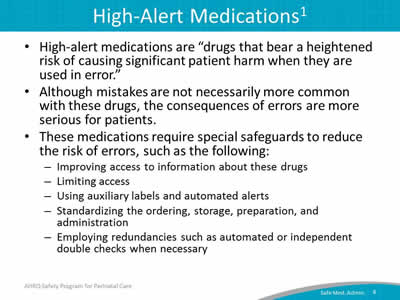
Say:
High-alert medications are defined by the Institute for Safe Medication Practices as "drugs that bear a heightened risk of causing significant patient harm when they are used in error."
Although mistakes are not necessarily more common with these drugs, the consequences of errors are more serious for patients. To reduce the risk of errors, these medications require special safeguards such as the following:
- Improving access to information about these drugs.
- Limiting access to these medications.
- Using auxiliary labels and automated alerts.
- Standardizing the ordering, storage, preparation, and administration.
- Employing redundancies such as automated or independent double checks when necessary.
Slide 5: Safe Medication Administration Tools
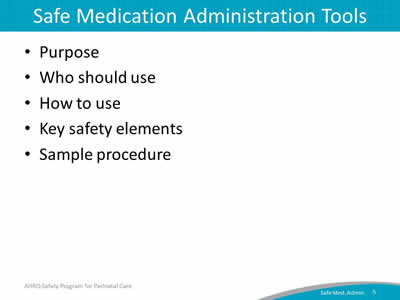
Say:
The purpose of the Safe Medication Administration tools are to provide a framework for safely administering oxytocin and magnesium sulfate. This framework is based on SPPC Key Safety Elements that describe what should be included to create a unit-specific procedure for oxytocin or magnesium sulfate administration.
Nurses, physicians, midwives, pharmacists, and other L&D unit staff involved in the preparation and administration of oxytocin and/or magnesium sulfate should use these tools.
To use these tools, review the key safety elements with L&D leadership and unit staff, determine how to implement elements within the unit, considering existing facility processes or policies related to oxytocin or magnesium use. Consider using preprinted orders, standing orders, and staff simulation training to support implementation.
The key safety elements will be reviewed in subsequent slides in more detail.
The sample procedure for each tool, located as an appendix with each tool, can be used as an example of how safety elements can be customized and operationalized into a unit’s procedure for medication administration; units can customize and adapt this example based on unit preferences.
Slide 6: SPPC Key Perinatal Safety Elements for Safe Medication Administration
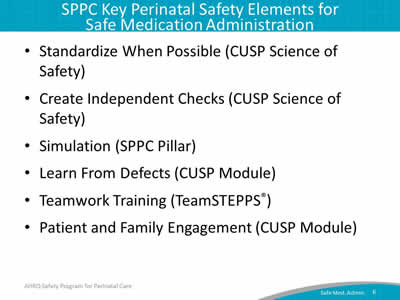
Say:
As in the other customizable bundles available through the SPPC, the key safety elements for safe medication administration are organized into the following six overarching principles of patient safety derived from the Comprehensive Unit-based Safety Program, or CUSP, and the TeamSTEPPS® teamwork and communication system. They include the following:
- Standardize When Possible.
- Create Independent Checks.
- Learn From Defects.
- Simulation.
- Teamwork Training.
- Patient and Family Engagement.
In the rest of this presentation, we will highlight each key safety element and how it applies to the administration of oxytocin and magnesium sulfate.
Slide 7: Oxytocin
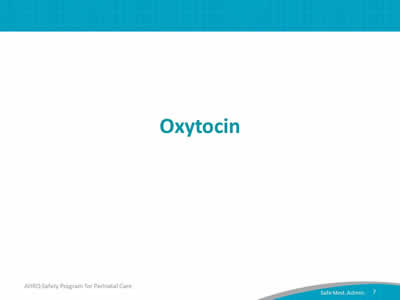
Say:
First, we will highlight some of the key safety elements from the tool for oxytocin, and then we will highlight some of the key safety elements from the tools for magnesium sulfate.
Slide 8: Rationale for Safe Medication Administration Tool
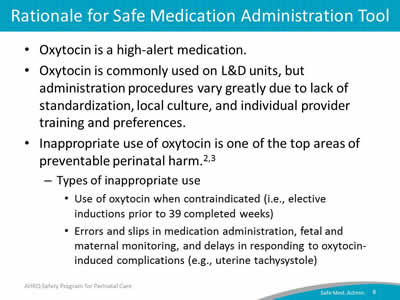
Say:
The safe medication administration of oxytocin is important for a few reasons:
- Oxytocin is a high-alert medication.
- Oxytocin is commonly used on L&D units, but administration procedures vary greatly due to lack of standardization, local culture, and individual provider training and preferences.
- Inappropriate use of oxytocin is one of the top areas of preventable perinatal harm.
- Common inappropriate uses of oxytocin include the following:
- Use of oxytocin when contraindicated (i.e., elective inductions).
- Errors and slips in medication administration, fetal and maternal monitoring, and delays in responding to oxytocin-induced complications (e.g., uterine tachysystole).
Slide 9: Key Safety Elements: Standardize When Possible
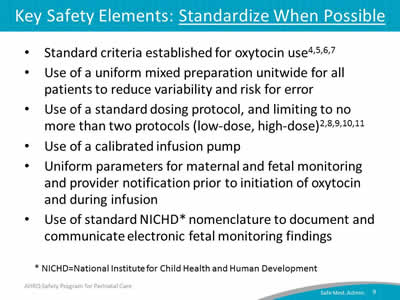
Say:
The first consideration for Safe Medication Administration of Oxytocin is to standardize when possible.
This is a core principle from the CUSP Science of Safety module. Standardizing procedures reduces and alleviates duplication of labor and resources, reduces unwarranted variation among providers and staff, and offers a predictable approach that encourages a shared mental model across the unit.
The key safety elements of standardizing when possible are the following:
- Having standard criteria established for oxytocin use, such as making sure that the criteria for use in labor induction or augmentation are met, and the lack of contraindications for use is verified and documented. An example of this element is "hard-stop" policies against the use of oxytocin for elective inductions prior to 39 completed weeks of gestation.
- A uniform mixed preparation of oxytocin for infusion is established and consistently used for all patients, for example 10 Units/L.
- A standard dosing protocol (that is, starting dose, incremental dose increase, frequency of increase, and maintenance dose) should be used consistently for all patients to reduce variability and risk of error. Both low- and high-dose protocols may be appropriate; thus, two standard dosing protocols may need to be defined: one for low-dose oxytocin and one for high-dose oxytocin.
- Other key elements for standardizing include use of a calibrated infusion pump, uniform parameters for maternal and fetal monitoring and provider notification, and use of standard National Institute for Child Health and Human Development (NICHD) nomenclature to document and communicate electronic fetal monitoring findings.
Slide 10: Key Safety Elements: Create Independent Checks
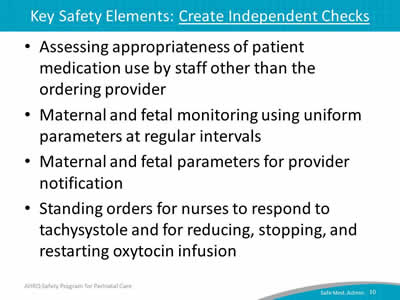
Say:
The second consideration for Safe Medication Administration of Oxytocin is to create independent checks.
This is also a core principle from the CUSP Science of Safety module. Independent checks help guarantee that the patient receives the highest quality of care possible. Independent checks can include checklists, protocols, and briefings with other staff. L&D unit staff are able to focus on patient care and have confidence that untoward events (change in patient condition, errors in dosing, etc.) will be caught by a check or team alert when they occur. For oxytocin administration, these may include—
- Assessing appropriateness of patient medication use by staff other than the ordering provider—an independent verification of indications and maternal and fetal status per unit-established standard criteria is recommended to minimize use in cases where risk may exceed benefit. Considerations include—
- Indications for use (e.g., medical induction, labor augmentation).
- Contraindications for use.
- Maternal status prior to initiation. For example, cervical status.
- Fetal status prior to initiation. For example, fetal presentation and station, and baseline fetal heart rate.
- Maternal and fetal monitoring using uniform parameters at regular intervals.
- Maternal and fetal parameters for provider notification.
- Standing orders for nurses to respond to tachysystole and for reducing, stopping, and restarting oxytocin infusion.
Slide 11: Key Safety Elements: Learn From Defects

Say:
The third consideration for Safe Medication Administration of Oxytocin is to learn from defects.
The key safety elements related to learning from defects for oxytocin administration include—
- Debriefing and analyzing near misses and adverse events related to oxytocin use
- Having a process in place to review inductions that occur outside of policy-defined indications. Each unit can decide its approach to reviewing these cases. This might incorporate an existing medical peer-review process or review by a perinatal safety or quality committee.
- Having a process in place to review severe maternal or neonatal morbidity and mortality events. Each unit can decide its approach to reviewing these cases. A resource for a sample process and review forms are available in the tool that accompanies this presentation.
- Share outcomes or process improvements from informal and formal analysis with staff to achieve transparency and organizational learning.
Slide 12: Key Safety Elements: Simulation
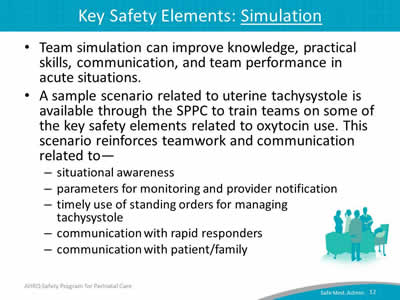
Say:
The fourth consideration for Safe Medication Administration of Oxytocin is simulation.
Team-based in situ simulation can improve knowledge, practical skills, communication, and team performance in acute situations.
A sample scenario related to uterine tachysystole is available through the SPPC to train teams on some of the key safety elements related to oxytocin use. This scenario reinforces teamwork and communication related to—
- Situational awareness.
- Parameters for monitoring and provider notification.
- Timely use of standing orders for managing tachysystole.
- Communication with rapid responders.
- Communication with patient/family.
Slide 13: Key Safety Elements: Teamwork Training
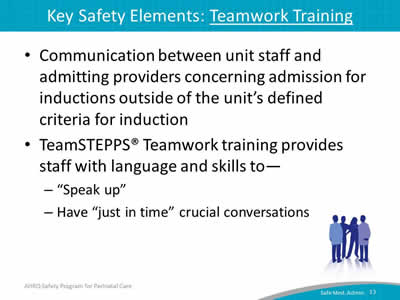
Say:
The fifth consideration for Safe Medication Administration of Oxytocin is teamwork training.
This aspect of perinatal safety calls for L&D units to foster a culture of teamwork and communication to promote effective teamwork. TeamSTEPPS® teamwork training offers several useful communication techniques applicable to the use of oxytocin.
These include the following:
- Communication between unit staff and admitting providers concerning admission for inductions outside of the unit’s defined criteria for induction. These techniques provide staff with the language and skills to "speak up" and have a "just in time" crucial conversation.
Slide 14: Key Safety Elements: Teamwork Training
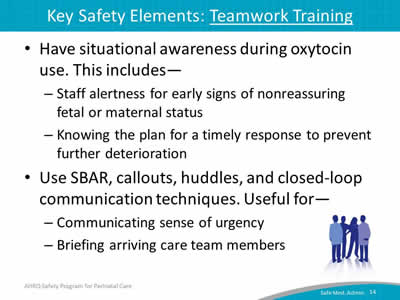
Say:
- Having situational awareness during oxytocin use. In the context of oxytocin use, this includes staff alertness for early signs of non-reassuring fetal or maternal status, and knowing the plan for a timely response to prevent further deterioration
- The use of SBAR or Situation, Background, Assessment, and Recommendation as well as callouts, huddles, and closed-loop communication among team members. These are useful for communicating a sense of urgency when requesting help responding to sudden changes in maternal or fetal status—for example, during an episode of tachysystole—and for briefing new care team members as they arrive to assist, and give or receive orders.
Slide 15: Key Safety Elements: Teamwork Training
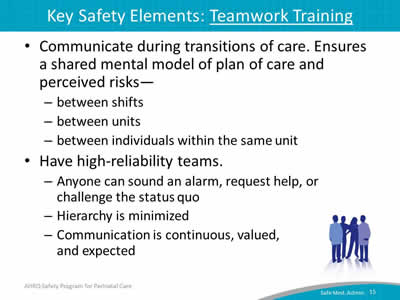
Say:
- Communication during transitions of care helps to ensure a shared mental model of plan of care and perceived risks between shifts, between units, or between individuals within the same unit.
- Having high-reliability teams, which means that anyone can sound an alarm, request help, or challenge the status quo; hierarchy is minimized; and communication is continuous, valued, and expected.
Slide 16: Key Safety Elements: Patient and Family Engagement
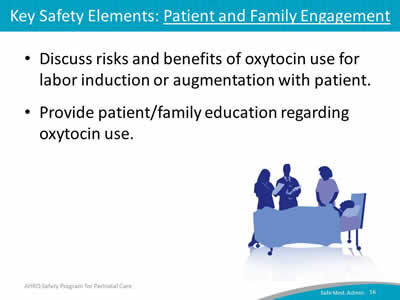
Say:
The sixth consideration for Safe Medication Administration of Oxytocin is patient and family engagement.
This aspect of perinatal safety calls for L&D units to engage patients and families in the process of their own care.
The key safety elements are the following:
- Discussing risks and benefits of oxytocin use for labor induction or augmentation with the patient based on the unit-established process.
- Educating patients and families regarding oxytocin use—for example, the infusion procedure, mobility restrictions, and expected therapeutic and side effects.
- Educating patients/families regarding expected signs and symptoms related to use, and providing instructions for reporting these to nursing staff.
Slide 17: Tool: Safe Oxytocin Administration
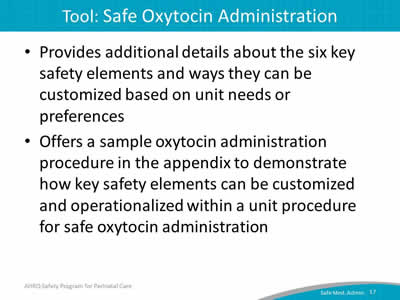
Say:
The Safe Medication Administration Oxytocin Tool, available on the AHRQ Web site, provides additional details for these six key safety elements just reviewed, including examples of how a unit might customize each element to unit needs or preferences. The appendix of this tool includes a sample oxytocin administration procedure, which demonstrates how key safety elements can be customized and operationalized within a unit procedure for safe oxytocin administration.
Slide 18: Magnesium Sulfate
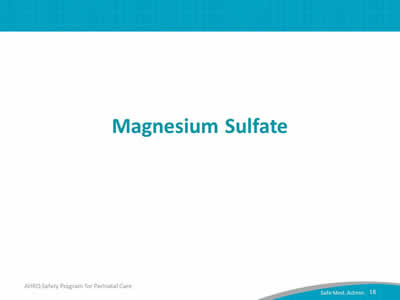
Say:
Now we will highlight some of the key safety elements from the tool for magnesium sulfate.
Slide 19: Rationale for Safe Medication Administration Tool
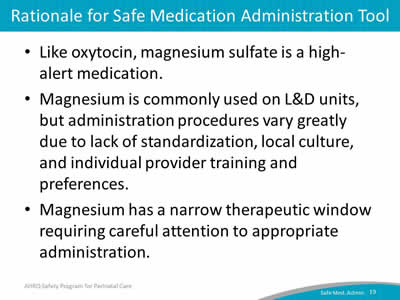
Say:
The safe medication administration of magnesium sulfate is important for a few reasons:
- Like oxytocin, magnesium sulfate is a high-alert medication.
- Magnesium is commonly used on L&D units, but administration procedures vary greatly due to lack of standardization, local culture, and individual provider training and preferences.
- Magnesium has a narrow therapeutic window requiring careful attention to appropriate administration.
Slide 20: Key Safety Elements: Standardize When Possible
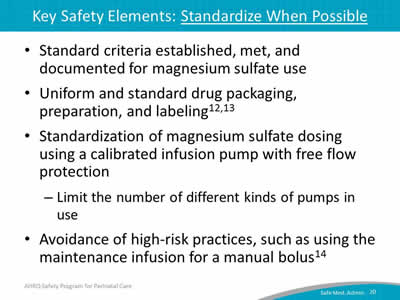
Say:
The first consideration for Safe Medication Administration of Magnesium is standardize when possible.
The key safety elements are the following:
- Having standard criteria for magnesium sulfate use established, and ensuring that individual patients have met criteria and that this is documented prior to use.
- Having uniform and standard drug packaging, preparation, and labeling. Pharmacy and nursing staff should use a consistent approach to labeling all magnesium sulfate bags and tubing used to administer the medication. The same standard preparation either premixed or pharmacy-prepared bags (e.g., 20 g/500 ml bag) should be used unit wide for maintenance infusion.
- Standardizing magnesium sulfate dosing using a calibrated infusion pump with free-flow protection. Limit the number of different kinds of infusion pumps to maximize staff familiarity with infusion equipment.
- Establish the unit’s standard approach for administering a loading dose (bolus). Using the maintenance infusion to administer a bolus manually is a high-risk practice that should be avoided.
Slide 21: Key Safety Elements: Standardize When Possible
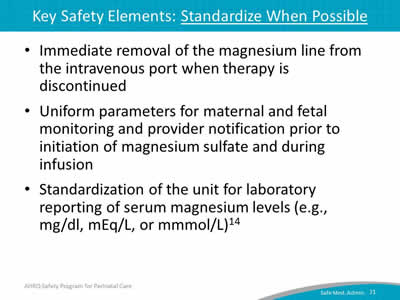
Say:
- When magnesium sulfate therapy is discontinued, remove the line from the intravenous port to avoid accidental infusion.
- Establishing uniform parameters for maternal and fetal monitoring and provider notification prior to initiation of magnesium sulfate and during infusion.
- Uniform reporting of serum magnesium levels (e.g., mg/dL, mEq/L, or mmmol/L). Bedside staff, providers, and lab personnel should agree on one unit for reporting and communicating magnesium levels to avoid miscommunication and delays in timely care.
Slide 22: Key Safety Elements: Create Independent Checks
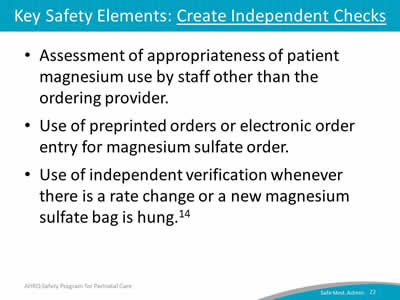
Say:
The second consideration for Safe Medication Administration of Magnesium is create independent checks.
The key safety elements for creating independent checks are the following:
- Assessing appropriateness of magnesium sulfate use in patient by staff other than the ordering provider.
- Using preprinted orders or electronic order entry for magnesium sulfate order.
- Using independent verification by a second qualified staff member whenever there is a rate change or a new magnesium sulfate bag is hung. This includes a check that the magnesium bag is clearly labeled and contains the correct dose, and that the tubing and pump are set up correctly.
Slide 23: Key Safety Elements: Create Independent Checks
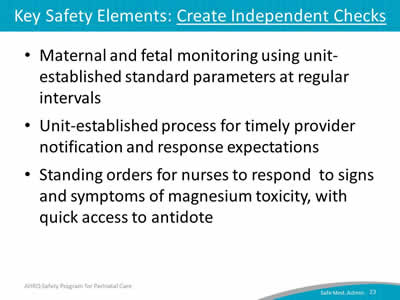
Say:
- Using the unit-established standard parameters for maternal and fetal monitoring at regular intervals while receiving magnesium sulfate.
- Ensuring that the unit has a process for timely notification and provider response expectations for when maternal or fetal parameters are out of range; unit should have a process for getting a rapid response to get additional "eyes" on the patient to prevent further deterioration.
- Using unit-established standing orders to allow nurses to provide initial management in response to suspected magnesium toxicity. Standing orders for can include—
- Activating a rapid response (i.e., call for additional help).
- Stopping the infusion.
- Monitoring vital signs, including oxygen saturation and respiratory rate and pattern.
- Administering the antidote (i.e., calcium gluconate).
Slide 24: Key Safety Elements: Learn From Defects
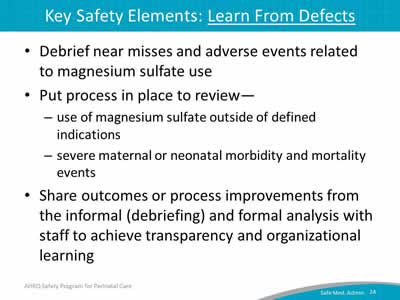
Say:
The third consideration of Safe Medication Administration of magnesium is learn from defects.
The key safety elements of learning from defects are the same as for oxytocin:
- Debriefing near misses and adverse events related to magnesium sulfate use.
- Putting a process in place to review use of magnesium sulfate and oxytocin use outside of defined indications and a process in place to review severe maternal or neonatal morbidity and mortality events. A resource for a sample process and review forms are available in the tool that accompanies this presentation.
- Sharing outcomes or process improvements from the informal (debriefing) and formal analysis with staff to achieve transparency and organizational learning.
Slide 25: Key Safety Elements: Simulation
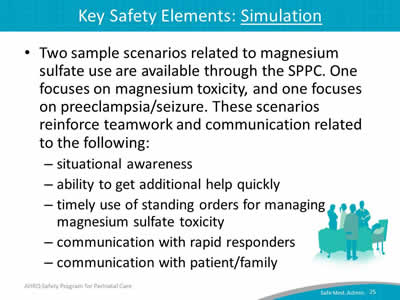
Say:
The fourth consideration for Safe Medication Administration of Magnesium Sulfate is simulation. Team-based in situ simulation can improve knowledge, practical skills, communication, and team performance in acute situations.
Two sample scenarios related to magnesium sulfate use are available through the SPPC to train teams on some of the key safety elements related to magnesium sulfate use. One focuses on magnesium toxicity, and one focuses on preeclampsia/seizure. These scenarios reinforce teamwork and communication related to—
- Situational awareness.
- Ability to get additional help quickly.
- Timely use of standing orders for managing magnesium sulfate toxicity.
- Communication with rapid responders.
- Communication with patient/family.
Slide 26: Key Safety Elements: Teamwork Training
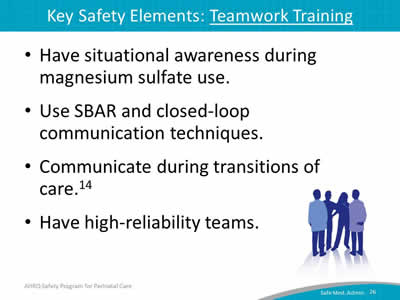
Say:
The fifth consideration for Safe Medication Administration of Magnesium Sulfate is teamwork training.
This aspect of perinatal safety is similar to what was discussed for oxytocin, and includes fostering a culture of teamwork and communication to promote effective teamwork. TeamSTEPPS® teamwork training offers several useful communication techniques applicable to the use of magnesium sulfate.
- Having situational awareness during magnesium sulfate use. Situational awareness refers to all staff caring for the patient knowing what the patient’s plan is through briefings and team management,
- Using SBAR, callouts, and closed-loop communication among team members. In the context of magnesium sulfate use, these techniques are particularly useful for communicating changes in maternal or fetal status to the care team, for checking back on orders given and received in an urgent situation, such as a seizure or magnesium toxicity, and for briefing a new care team member who arrives to help with a rapid response.
- Using transition communication techniques to ensure a shared mental model of plan of care and perceived risks between shifts or between units. This may include bedside review by nursing team of pump settings, mainline intravenous fluids, and written orders for magnesium sulfate.
- Having high-reliability teams.
Slide 27: Key Safety Elements: Patient and Family Engagement
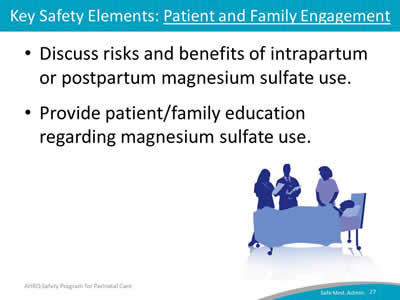
Say:
The sixth consideration for Safe Medication Administration of Magnesium is patient and family engagement.
The key safety elements are the following:
- Having unit-established processes for conveying risks and benefits of magnesium sulfate use to patient and family.
- Educating patients and families regarding magnesium use—for example, the infusion procedure, mobility restrictions, and expected therapeutic and side effects.
- Educating patients and families regarding the frequency of nursing assessment and monitoring, signs and symptoms to report to nursing staff, and instructions for requesting urgent assistance.
Slide 28: Tool: Safe Magnesium Sulfate Administration
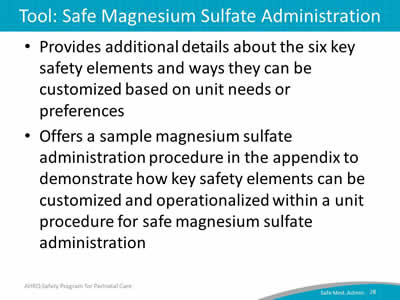
Say:
The sample procedure, provided as an appendix to this tool, demonstrates how key safety elements can be customized and operationalized within a unit procedure for magnesium sulfate administration.
Slide 29: Customizing the Key Elements
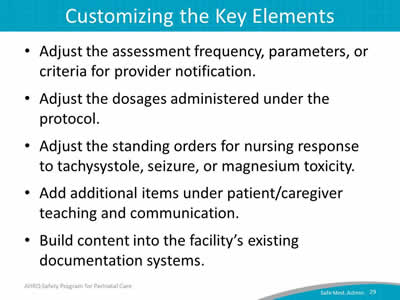
Say:
These key safety elements for safe medication administration can be customized by the unit to develop tools for the administration of oxytocin and magnesium sulfate. This customization can involve—
- Adjusting the assessment frequency, parameters, or criteria for provider notification.
- Adjusting the dosages administered under the protocol.
- Adjusting the standing orders for nursing response to tachysystole, seizure, or magnesium toxicity.
- Adding additional items under patient/caregiver teaching and communication.
- Building content into the facility’s existing documentation systems.
Slide 30: Unit Next Steps
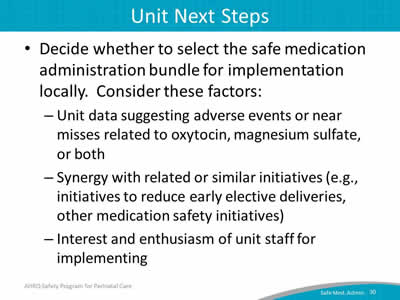
Say:
The next steps for a unit are as follows:
- Decide whether to select the safe medication administration bundle for implementation locally. Consider these factors:
- Unit data suggesting adverse events or near misses related to oxytocin, magnesium sulfate, or both.
- Synergy with related or similar initiatives (e.g., initiatives to reduce early elective deliveries, other medication safety initiatives).
- Interest and enthusiasm of unit staff for implementing.
Slide 31: Unit Next Steps
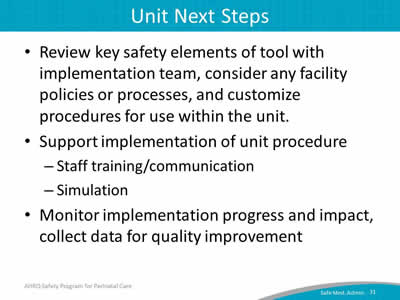
Say:
- Review Key Safety Elements tool with the implementation team, considering any facility policies or processes, and customize procedures for use within the unit.
- Support implementation of unit procedure.
- Staff training/communication.
- Simulation.
- Monitor implementation progress and impact, collect data for quality improvement to refine the unit approach to the safe use of these high-alert medications.
Slide 32: Tips for Implementation Success
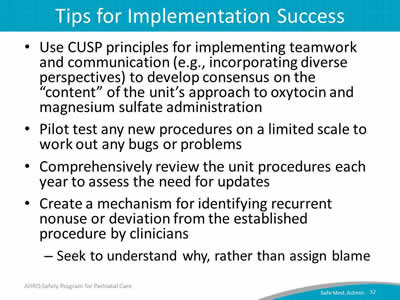
Say:
Here are some tips for implementing these tools successfully:
- Use CUSP principles for implementing teamwork and communication (e.g., incorporating diverse perspectives) to develop consensus on the unit’s approach to oxytocin and magnesium sulfate administration.
- Pilot test any new procedures on a limited scale to work out any bugs or problems.
- Comprehensively review the unit procedures each year to assess the need for updates to ensure content is up to date.
- Create a mechanism for identifying recurrent nonuse or deviation from the established procedure by clinicians. Seek to understand why, rather than assign blame.
Slide 33: References
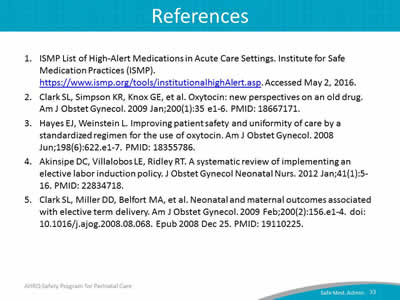
Slide 34: References
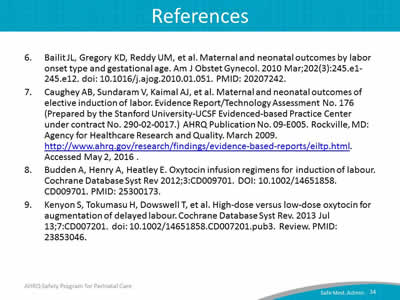
Slide 35: References
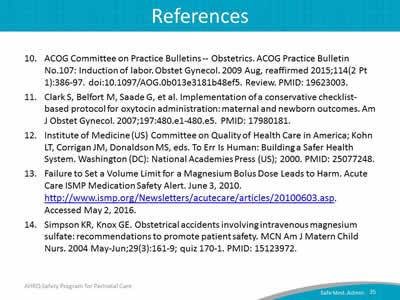
Slide 36: Disclaimer
